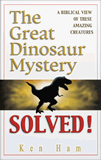
Jurassic Spark?
Hatching Dinosaurs from Chicken Eggs?
Do chickens really take on “dinosaurian traits” inside the egg as one paleontologist claims? Dr. Elizabeth Mitchell, AiG–U.S., shows why there’s more fluff to this claim than fact.
We recently received the following request:
I quote from The Reader’s Digest August, 2010 article “Jurassic Spark” where paleontologist Hans Larsson states “Chicken embryos...start off looking fairly generic...As the embryo continues to transform, there’s a brief window when . . . it takes on dinosaurian traits. For a mere ten hours, the chicken embryo has five fingers with pointed and claw-like tips, a hint of teeth and a tail (up to 22 vertebrae, roughly 15 more than in a developed chicken). Then suddenly, a genetic switch flips: The teeth disappear, the tail is destroyed and the five fingers become three.”
How would you respond to this?
The article in Reader’s Digest (Canadian edition) came from a Macleans article entitled “The Quest to Build a Dinosaur.”
Reading this article is very entertaining—if you like science fiction—and discussing it with your friends should provide countless opportunities to draw a line between reality and fantasy. Paleontologists Jack Horner—advisor on the Jurassic Park movies—and Hans Larsson are, however, quite serious when they talk about their efforts to genetically alter chicken embryos to turn them into dinosaurs. Why do they wish to do this? As Horner states, “You can’t make a dinosaur out of a chicken, if evolution doesn’t work.” In other words, they would like to “spark . . . a public debate about evolution by winding its tape backwards for all to see.”
Horner is strongly committed to the notion that dinosaurs evolved into birds. As Dr. Tommy Mitchell points out in his presentation called Jurassic Prank, Horner, in the “Special Features” section of the Jurassic Park DVD, states:
The whole idea is to get people to look at dinosaurs more like birds than reptiles. In one of the scenes, some of the model makers had made a tongue come out like a lizard or a snake . . . . We know they didn’t do that. Had that been left in the scene, all that work into making these things birdlike would have been gone.
Unlike the characters in the movie, real scientists do not have any dinosaur DNA. (None of the dinosaur soft tissues found by Mary Schweitzer have provided any DNA.) With no dinosaur DNA, they have nothing to clone. Instead, Larsson and Horner are trying to alter the development of chicken embryos in hopes of producing mutant chickens with tails, forearms, and teeth. They admit, however, that even if they could get something like this to happen, the creature would “still have a chicken genome.”1 In other words, it would not be a dinosaur, just a funny looking chicken. (Larsson would disagree, however, since he says, “Chickens are dinosaurs.”)
Notice that even with induced mutations thought to mimic evolutionary ones, these scientists acknowledge that their creation would not be a dinosaur because it would not contain dinosaur DNA. Mutations do not create new information; they just reshuffle, misplace, turn on or off, or lose information that is already there. Evolution of one kind of animal into another kind would require new information to be created.
In a sadly accurate comparison, the article recalls the tragedy of thalidomide, a teratogenic (birth-defect causing) drug given to treat morning sickness in Europe in the 1960s. These children were fully human and suffered from a variety of problems, including blunted development of the limbs. (This congenital malformation is called phocomelia, a name coined from Greek words that describe the resemblance of the limbs to the flippers of a seal.)
Thalidomide is thought to have caused these defects by inserting itself into the DNA of the developing baby and preventing certain genes related to limb development from being activated. The article notes that this mutation had “nothing to do with development or evolution,” even though these children had “flipper-like hands and feet.” In fact, this mutation had nothing to do with evolution because these children were still fully human. But, actually, the mutation caused by thalidomide in many ways resembles the process Larsson and Horner are trying to trigger: the turning off or on of certain genes. And just as thalidomide babies were still human babies, a mutant chicken is still a chicken.
Some biology textbooks continue to present the recapitulation myth as evidence for evolution.
Disturbingly, in this article, a concept that should now be as extinct as the dinosaurs rises from Ernst Haekel’s grave. The notion that “ontogeny recapitulates phylogeny”—an idea held by both Darwin and Haekel—presumed that the developmental stages of an embryo retrace its evolutionary past.2 In spite of the fact that Haekel’s diagrams were known to be frauds almost immediately after they were published,3 some biology textbooks continue to present the recapitulation myth as evidence for evolution.4 Relying on embryonic recapitulation, Larsson attempts to stop the chicken embryo from losing its so-called dinosaur characteristics. He says that for 10 hours the chicken embryo has “dinosaurian traits,” and he is trying to “override” the genetic mandate the creature has to lose these traits and become a bird.
One of these “dinosaurian traits” is a tail, or rather, to be more accurate, a tail-bud that resembles a tail.5 Paleontologist Larsson claims that the chicken embryo briefly possesses “a tail (up to 22 vertebrae, roughly 15 more than in a developed chicken).”6 This statement is misleading. As embryos develop, they form a series of somites. Somites are blocks of embryonic tissue genetically programmed to develop into specific tissues (such as muscle, skin, and bone) and to direct the organization of other nearby structures such as nerves. The disappearance of these “extra” somites in chick embryos involves a combination of transformation into other structures, migration to other locations, and some genetically programmed cell death.
Research has suggested that the genetically programmed death of the cells in some of these somites (a process called apoptosis) serves to regulate the development of neighboring structures.7 But even if these “genetic switches” could be disabled, the resulting malformations would result in defective chickens, not dinosaurs.
The hope of these scientists—to switch on the dinosaur genes and switch off the chicken genes—depends on the notion that the dinosaur information is actually there in the chicken genome but just deactivated (never mind the question of where that genetic information came from in the first place). One scientist in the article states, “Evolution doesn’t always rely on the development of new genes. It’s redeploying old genes in new ways: changing their switches, or their time of activity.”
In other words, the claim that “most creatures share many of the same genes,” coupled with the discovery of “homeobox” genes in fruit flies, genes that can switch on or off the development of body parts in certain places,8 is used to imply that the genetic information is the same for most things anyway and only has to be switched on or off to evolve a new kind. The article hastens to remind us of the claim that human and chimp DNA is “about 99 percent identical.” Statistically speaking, that number is not very accurate. The way some information is counted and other informational differences are ignored artificially inflates that percentage. Moreover, using percentages hides an important fact: “If 5% of the DNA is different, this amounts to 150,000,000 DNA base pairs that are different between them!”9
Clearly, there are many proteins and other molecules that show up in multiple creatures. Therefore, it is not surprising to find that the DNA blueprints to make these chemicals appear to be “cut-and-pasted” throughout the living creatures of the world. But why should this come as a surprise? Did not the same Creator, according to the Bible, create all these living creatures? Is there some reason we should have expected that God ought to have invented a whole different kind of biochemistry for each and every creature?
If we, as mere human beings, can use the same inventions in multiple places and for multiple uses, should it surprise us that God used His good ideas in a variety of places? When we see common designs, or common components, our own worldview determines whether we shout “common Designer” or “common ancestor.”
After pointing out that some DNA from other extinct species has been recovered, such as the DNA from the hair of the woolly mammoth, the article explores the possibility of cloning. Here the article raises a hypothetical but disturbing ethical issue: if a Neanderthal could be cloned from DNA—presumably without all the horrid problems10 inherent in the reproductive cloning process as revealed by Dolly11—what would its moral status be? Now, the fact is, Neanderthals were as human as you or I.12 However, this article asks whether this “sibling species” would be kept “in a zoo . . . treated as a low-functioning human . . . . Would it be closer to an ape, or to a person?” Knowing the tragic story of Ota Benga, an African pygmy displayed in a zoo because he was thought to occupy an inferior position on the evolutionary ladder, these hypothetical questions have a frightening ring.
Maybe this article isn’t so entertaining after all.
Elizabeth Mitchell, MD
For More Information
Footnotes
- The genome of an organism is all its genetic material. Every somatic cell in an individual organism contains identical genetic material, and that set of chromosomes determines what kind of organism that individual is, as well as its specific characteristics. The DNA in an organism’s cells even contains the regulatory information to tell which cells to develop which way, activating and deactivating genes as needed to make eyes be eyes and livers be livers. But such activation cannot uncover dinosaur genes in a chicken because a chicken’s cells have chicken genomes. If a chicken developed a tail, it would be a chicken with a tail, not a dinosaur.
- Darwin stated his belief that “the embryos of mammalia, of birds, lizards, and snakes . . . are in their earliest states exceedingly like one another, both as a whole and in the mode of development of their parts; so much so, in fact, that we can often distinguish the embryos only by their size” (page 338). He also said that “community in embryonic structure reveals community of descent” from the “ancient progenitor” (page 345). Charles Darwin, The Origin of the Species by Means of Natural Selection or the Preservation of Favored Races in the Struggle for Life and The Descent of Man and Selection in Relation to Sex (New York: The Modern Library, 1859).
- See Something Fishy About Gill Slits!.
- An article in Science (volume 277 (1997):1435) states, “Generations of biology students may have been misled by a famous set of drawings of embryos published 123 years ago by the German biologist Ernst Haeckel. . . . They show vertebrate embryos of different animals passing through identical stages of development. But the impression they give, that the embryos are exactly alike, is wrong, says Michael Richardson, an embryologist at St. George’s Hospital Medical School in London. He hopes once and for all to discredit Haekel’s work, first found to be flawed more that a century ago.”
- In embryology, many structures get named on the basis of our preconceptions about what they look like or what they ought to be rather than according to what they actually become. A prime example are the so-called “gill slits” in human embryos, which, of course, do not have anything to do with gills and are not even slits, just folds of tissue destined to develop into various anatomical parts of the head and neck. See Something Fishy About Gill Slits! for more information.
- In a 2008 article on the same subject, Larsson’s work is described as follows: “Looking at a two-day chicken embryo, he made an unexpected discovery. Expecting to see between four and eight vertebrae present in the developing spine, his microscope instead picked out 16 vertebrae—effectively a reptilian tail.” However, as documented [PDF] by Hamburger and Hamilton’s research in normal embryonic chick development, a 45–49 hour embryo has 16 somites, a 48–52 hour embryo has 19 somites, and beyond “stage 14,” which has 22 somites, “the number of somites is difficult to determine with accuracy.” Thus, the embryo does not actually have vertebrae, but somites.
- Sue Ann Miller and Ailish Briglin, “Apoptosis Removes Tail Gut and Remnant of Primitive Streak,” [PDF] Developmental Dynamics 206 (1996): 212–218.
- For more, see Hox Hype: Has Macro-Evolution Been Proven?
- For more on this topic, see Greater than 98% Chimp/Human DNA Similarity?
- The Center for Genetics and Society has issued a report concluding: “Reproductive cloning is inherently unsafe. At least 95% of mammalian cloning experiments have resulted in failures in the form of miscarriages, stillbirths, and life-threatening anomalies; some experts believe no clones are fully healthy. The technique could not be developed in humans without putting the physical safety of the clones and the women who bear them at grave risk.”
- In August 2010, Dr. Ian Wilmut, the researcher whose efforts 13 years ago produced the cloned sheep Dolly, discussing the prospect of human reproductive cloning, said it was “frightening . . . . While there are ethical and psychological objections, the main problem is safety. Cloning is linked to a higher death rate for fetuses and problems during birth . . . . Wilmut concludes that to clone human beings would be ‘utterly irresponsible.’”
- See Are Europeans Neanderthal? and News to Note, May 3, 2008.
Recommended Resources

Answers in Genesis is an apologetics ministry, dedicated to helping Christians defend their faith and proclaim the good news of Jesus Christ.
- Customer Service 800.778.3390
- © 2024 Answers in Genesis






